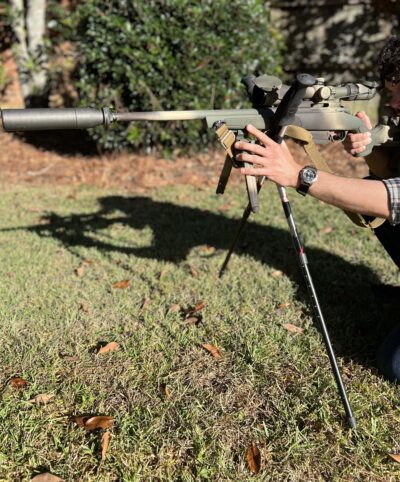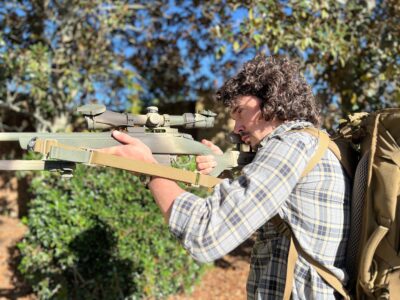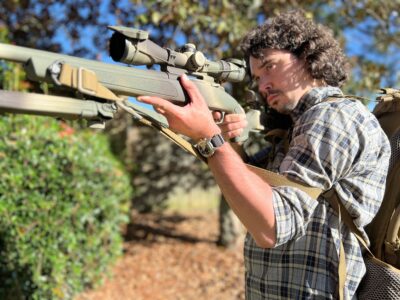Improvised Shooting Rest
Taylor Hutchinson 10.30.23

Various techniques and tricks for bringing a rifle to bear on a target have been passed down from generation to generation. Standing on the shoulders of giants, we come to understand that rifle craft takes training and time. Breathing, trigger control, stance, grip, and sight picture are all important fundamentals to master when it comes to shooting. Even when all of these are on point, reducing our “wobble zone” takes some added ingenuity. Taking an accurate shot, especially at a distance, comes down to having a good natural point of aim while behind the gun. Everyone’s body types and rifles are set up differently, and being comfortable while on the rifle aids in shot-to-shot accuracy. If the shooter is uncomfortable or straining muscles, it’s only a matter of time before fatigue sets in. Not every target is poised to be engaged from the prone position. While these techniques aren’t unique or novel, they have an honest track record of harvested game and medals attributed to them. These methods allow for typically uncomfortable positions to become more stable. Use them wisely and they can transform a hunting season.
Backpack
Nylon or waxed canvas dedicated shooting bags are popular at PRS matches. This is for a good reason. These ruggedized bean bags give the shooter unmatched stability and customization for various shooting challenges. They make bags for various needs, from rifle stock rest to bags that go in between creases of the body in unconventional shooting positions. These “gamer” bags are great for winning competitions, but a more practical solution for field use is already on our back.

Hunting, hiking, or even everyday backpacks if used properly are a great shooting aid to find a stable shot. One method involves resting the rifle on bipods or another support, then stuffing the pack between the shooting arm’s elbow and pinning it against the body or knee. Using this in a variety of shooting positions, the pack fills the space on the back side of the rifle. This creates rearward stability and allows the shooter to keep chest-to-stock contact to a minimum, thus not allowing breathing or sudden movements to shift their point of aim. Alternatively, allowing the rifle to rest on the pack in the prone position offers supplemental forward support. In certain terrains, this is advantageous where having to rely on a rigid bipod for stability is less desirable.
Hiking Sticks
Since the invention of the firearm, shooters and hunters have relied on shooting sticks. Over time, these tools have evolved, becoming increasingly sophisticated. While they were made from wood in the early 19th century, today’s shooting sticks are constructed from modern materials like carbon fiber and aluminum. Modern versions are lightweight and have adjustable height for various shooting positions. Designs for monopods, bipods, and more popular lately the shooting tripod. These have advantages and disadvantages but can strike a balance between weight and stability.

Having dedicated shooting sticks isn’t always feasible or justified when on more extended stalking hunts. Hiking sticks when set up properly serve a dual purpose. Hunters that stalk over long distances more than likely already have these in their hunting pack. Fashioning the hand straps through the tops of adjacent hiking sticks allows for counter-pressure when forming a V-shaped rest. Digging the bottom end of the stick into the ground creates a steady makeshift bipod. Most hiking sticks are adjustable, allowing them to be adapted for seated, kneeling, or standing shooting positions. Pinning the hiking sticks against a natural structure also provides additional support to stabilize a shot.
Sling
It’s often said that a sling to a rifle is as a holster is to a pistol. Yes, a sling is designed to carry the rifle and keep the rifle attached to the body when needing to go hands-free. However, it is also used as a shooting aid, especially when no other shooting rest is available. The sling is the most versatile shooting aid for a rifleman. Most modern slings are adjustable, allowing the shooter to quickly change the length of the sling. When the rifle is slung, a rifleman can alter sling tension from loose to very tight quickly by utilizing the quick adjustment slider. This is able to be done while staying on target and using their support hand to adjust sling tension to its tightest point. The rifleman’s reticle wobble is drastically reduced whether standing, kneeling, or squatting.

The sling can also be used to brace against a tree or other support structure. Wrapping the sling around the support hand, bracing the rifle against an object, and resting the rifle on the web of the hand can provide additional support. Lastly, another option is the classic “hasty sling.” When the shooter is out of the sling and has the sling adjusted fairly short, they start by passing the support hand through the loop of the sling. Then wrapping the support arm back around the sling and gripping the underside of the gun. This provides an ideal amount of tension and is tightened by either moving the elbow closer to the chest or shortening the length of the sling. While sling tension is employed by shooters to improve stability and thereby accuracy, it can cause stress to the rifle’s stocks or barrel if employed improperly. This will result in inconsistent shot groups or shifting points of impact.

These shooting aids do not make a rifle or shooter more accurate. They do provide improvised techniques that allow a rifleman to focus on the fundamentals of shooting. What makes a rifleman more accurate is becoming more accustomed to their rifle and equipment. Getting outside their comfort zone and trying something different they aren’t good at. Stretching their rifle’s legs and seeing what they are truly capable of. Practicing these techniques and learning others is what makes a well-rounded marksman.

